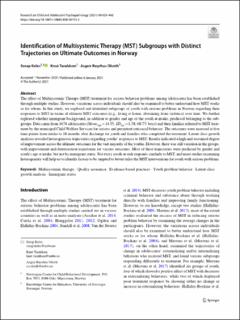| dc.contributor.author | Keles, Serap | |
| dc.contributor.author | Taraldsen, Knut | |
| dc.contributor.author | Olseth, Asgeir Røyrhus | |
| dc.date.accessioned | 2023-02-16T08:17:18Z | |
| dc.date.available | 2023-02-16T08:17:18Z | |
| dc.date.created | 2021-01-08T12:39:35Z | |
| dc.date.issued | 2021 | |
| dc.identifier.citation | Keles, S., Taraldsen, K., & Røyrhus Olseth, A. (2021). Identification of Multisystemic Therapy (MST) Subgroups with Distinct Trajectories on Ultimate Outcomes in Norway. Research on child and adolescent psychopathology, 49, 429-442. | en_US |
| dc.identifier.issn | 0091-0627 | |
| dc.identifier.uri | https://hdl.handle.net/11250/3051308 | |
| dc.description.abstract | The effect of Multisystemic Therapy (MST) treatment for serious behavior problems among adolescents has been established through multiple studies. However, variations across individuals should also be examined to better understand how MST works or for whom. In this study, we explored and identified subgroups of youth with serious problems in Norway regarding their responses to MST in terms of ultimate MST outcomes (e.g., living at home, abstaining from violence) over time. We further explored whether immigrant background, in addition to gender and age of the youth at intake, predicted belonging to the subgroups. Data came from 1674 adolescents (MeanAge = 14.55, SDAge = 1.58; 60.7% boys) and their families referred to MST treatment by the municipal Child Welfare Services for serious and persistent antisocial behavior. The outcomes were assessed at five time-points from intake to 18-months after discharge for youth and families who completed the treatment. Latent class growth analyses revealed heterogeneous trajectories regarding youths’ responses to MST. Results indicated a high and sustained degree of improvement across the ultimate outcomes for the vast majority of the youths. However, there was still variation in the groups, with improvement and deterioration trajectories for various outcomes. Most of these trajectories were predicted by gender and youth’s age at intake, but not by immigrant status. Not every youth-at-risk responds similarly to MST, and more studies examining heterogeneity will help us to identify factors to be targeted to better tailor the MST interventions for youth with serious problems. | en_US |
| dc.language.iso | eng | en_US |
| dc.publisher | Springer | en_US |
| dc.rights | Navngivelse 4.0 Internasjonal | * |
| dc.rights.uri | http://creativecommons.org/licenses/by/4.0/deed.no | * |
| dc.title | Identification of Multisystemic Therapy (MST) Subgroups with Distinct Trajectories on Ultimate Outcomes in Norway | en_US |
| dc.type | Peer reviewed | en_US |
| dc.type | Journal article | en_US |
| dc.description.version | publishedVersion | en_US |
| dc.rights.holder | The authors | en_US |
| dc.subject.nsi | VDP::Medisinske Fag: 700 | en_US |
| dc.source.journal | Journal of Abnormal Child Psychology | en_US |
| dc.identifier.doi | 10.1007/s10802-020-00735-3 | |
| dc.identifier.cristin | 1867721 | |
| cristin.ispublished | true | |
| cristin.fulltext | original | |
| cristin.qualitycode | 2 | |

